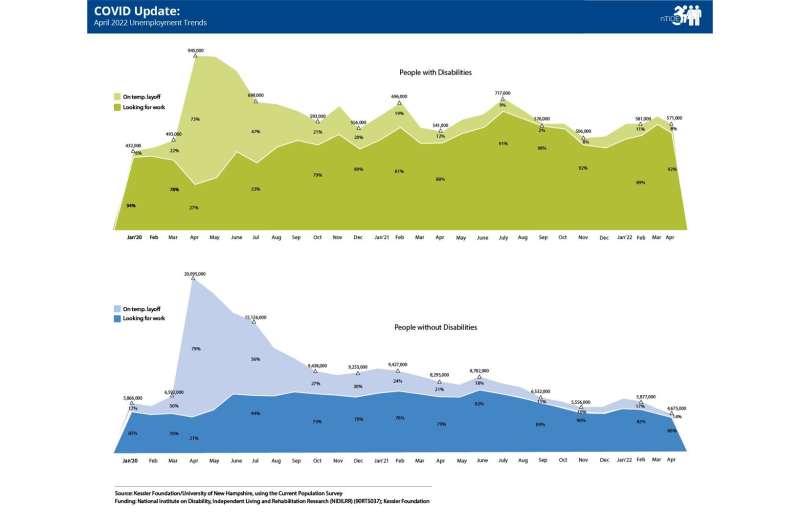These graphics compare the impact of the COVID-19 pandemic on people with and without disabilities, capturing pre-pandemic and current unemployment data from January 2020 to April 2022. April numbers showed small declines in unemployment for both groups; temporary layoffs remained steady for both groups. Credit: Kessler Foundation
Jobs data showed small declines in unemployment for people with and without disabilities in April, according to Friday's National Trends in Disability Employment (nTIDE) COVID Update. The April data also showed that the number of workers still on temporary layoff remained relatively unchanged, which may reflect persistent delays in the supply chain, according to nTIDE expert Andrew Houtenville, Ph.D., professor of economics at the University of Hampshire (UNH) and research director of the UNH Institute on Disability.
"Over the past four months, the number of unemployed has been relatively steady for people with disabilities, hovering around 590,000, compared with 460,000 prior to the pandemic," said Dr. Houtenville. "In our May 6 nTIDE, we reported a similar trend for their labor force participation rate, also suggesting there's not a lot of movement for people with disabilities." Unemployment for people without disabilities has shown a slow but steady decline over the past two years. "We see greater variability in the data for people with disabilities," he noted, "which relates to their smaller sample size."
As workers strive to recover from the effects of the COVID-19 pandemic, other factors are likely to influence future trends. Despite the continued strength of the labor market, the rise in inflation and counter measures to slow the economy may contribute to increases in unemployment. "We need a 'soft landing' when bringing down inflation," Dr. Houtenville cautioned, "to minimize the risk for recession, and maintain momentum in the labor market for all workers, including people with disabilities."
Field notes—News from SHRM and Job Path NYC
Demand for workers remains high, prompting human resource professionals to expand their recruiting efforts. Many employers are interested in hiring workers with disabilities but lack the skills and knowledge to do this successfully. A new certificate program from the SHRM Foundation, the philanthropic arm of the Society for Human Resource Professional (SHRM), equips HR professionals, people managers and business leaders with the knowledge and tools they need to recruit, hire, and retain individuals with disabilities, according to Elaine E. Katz, MS, CCC-SLP, senior vice president of grantmaking and communications at Kessler Foundation. A Kessler Foundation grant allows free and open access to Employing Abilities at Work, a 10-hour certificate program comprising seven training modules. "The Employing Abilities at Work certificate is a great opportunity for businesses to prepare to meet their hiring needs in a competitive labor market," Katz emphasized, "and reap the benefits of diversifying their workforces."
COVID-19 cases are rising in New York City, home to Job Path NYC, a nonprofit that provides customized employment services for people with intellectual and developmental disabilities. nTIDE co-author John O'Neill, Ph.D., director of the Center for Employment and Disability Employment Research at Kessler Foundation is on the board of Job Path NYC. "Businesses are continuing to open up in the city despite the rise in cases," he said, "and we are seeing workplaces continue to adapt to the changing environment. "While some jobs related to cleaning services are being eliminated, some new types of jobs based on digital communications have emerged as a result of pandemic restrictions. Sadly, we are also seeing some job losses due to closures of small businesses that remained open during the height of the pandemic but are now succumbing to the prolonged stresses of business restrictions, supply issues, and staff shortages."
Provided by Kessler Foundation
























